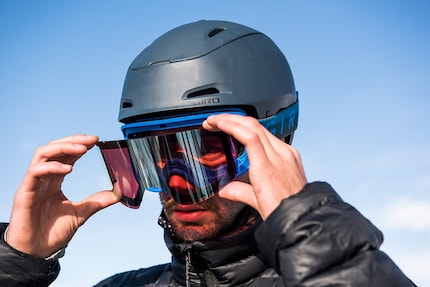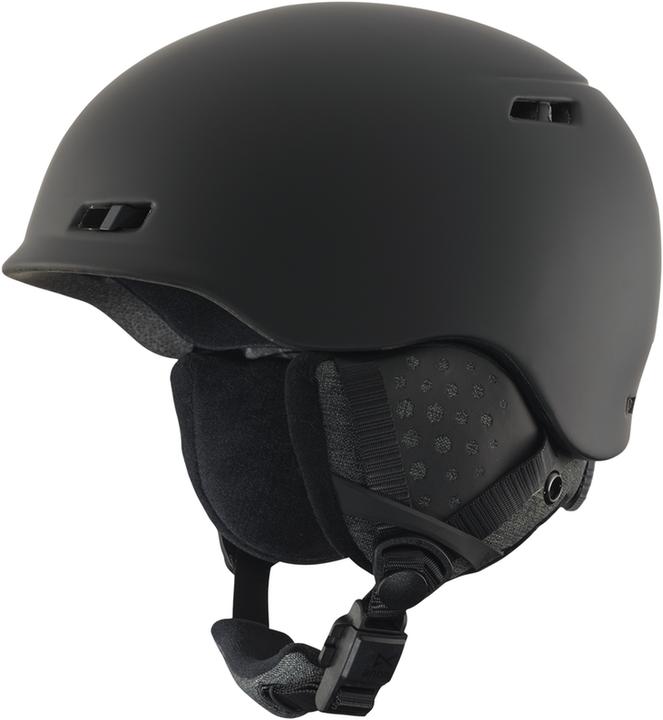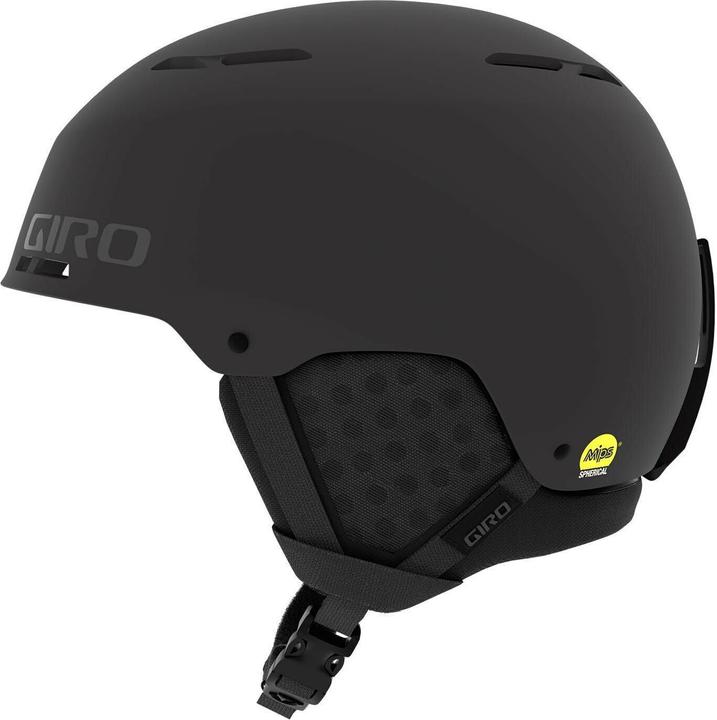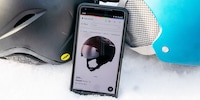

Quick guide to finding the right ski helmet
Looking for a new ski or snowboarding helmet? It’s hard to know where to start when you’re bombarded with terms like in-mold, hybrid and MIPS. We’ll help you get to grips with the lingo faster than you can say Acrylonitrile Butadiene Styrene. And more importantly, help you pick the right type of helmet. As you’d expect, different types of helmets have different advantages.
At first glance, they might look slopes apart but they somehow all seem the same. The protective casing makes them look so similar that it's hard to tell the way they're made or when they need to be replaced. Given ski and snowboard helmets have been a fixture of standard equipment for years, hardly anyone hits the slopes without one these days and that’s what makes the shell so important.
How often should you replace a ski helmet?
Even if you treat your helmet with as much care as a fresh egg, it’s not going to last forever. Uvex give the maximum lifetime for their ski helmets as eight years from the manufacture date – hint: you can find that printed on the inside of your helmet. However, they recommend you replace your helmet every three to five years, which is in line with guidance from other manufacturers. Of course, it’s in their interest to sell new helmets regularly rather than to get sued over a product failure. Meanwhile, K-Tipp has tested older helmets. Almost all of them passed the safety test (details in German). But «almost all» of the helmets has the potential to mean one results in a fatal accident. When you look at it like that, investing in a good helmet every five years seems reasonable within the scope of general winter sports costs. Besides, after that length of time there are bound to be new systems and features worth considering. And if you do have a serious fall, you should replace your helmet quickly – the hope being your ski helmet took the brunt of the accident more than you. But on the whole, it’s up to you to look after your ski helmet well.
How to store your ski or snowboarding helmet
The best way to ensure your ski helmet lasts for a long time is to store it somewhere dry and dark. Storing a ski helmet in direct sunlight is as harmful as keeping it somewhere damp. On that note, it’s best not to shove it between the suitcases and your old removal boxes in the basement. It sounds rather obvious but you don’t want anything weighing down on it. If you decide to store it away in summer, try to avoid it dropping and falling off the edge of the chair or boot of your car. For me at least, that’s almost unavoidable but it hasn’t given me cause to buy a new helmet quite yet.

What are ski helmets made of?
All the ski helmets you get in this part of the world have been tested and either meet the standards for full-shell helmets that also cover the ears (EN standard 1077 A) or half-shell helmets (EN standard 1077 B) that come with soft ear cushions. The three types of helmets you’ll find on the market are hard shell, in-mold and hybrid.
Hard shell
Outer shell
Hard shell ski helmets usually have an ABS outer shell for impact protection. ABS or Acrylonitrile Butadiene Styrene to give it its full name is a plastic that is break-resistant and has high impact resistance. Sharp objects can’t penetrate its surface and any impact energy gets distributed across the whole shell. All in all, it has great properties. The only thing that’s missing is absorption – and that’s where the inner shell comes in.
Inner shell
The inner shell is usually made of EPS, which stands for «expanded polystyrene» but is commonly known as Styrofoam. If you were to fall, the inner shell material would absorb a significant amount of the impact energy and thereby protect your head. But in doing so, the EPS would get misshapen or even break. That’s why you can’t rely on a helmet to protect you once you’ve had a serious fall – and why you always need to replace it after a bad accident. EPS is also insulating, which is a welcome side effect in cold temperatures. Outer and inner shells are glued together in hard shell helmets. This makes it possible to integrate sophisticated ventilation systems, which direct the airflow through the helmet in order to remove excess heat and moisture. Even models with an integrated visor such as the uvex 500 Vario are usually hard shell helmets.

Advantages:
- enhanced safety
- option for complex ventilation systems
- available with integrated visor.
Disadvantages:
- Hard shell helmets are usually a bit bulkier and heavier. More expensive helmets also harness carbon fibres and other impact-resistant materials that are lighter than ABS.
Popular with:
- sporty skiers and racers
In-mold
An in-mold helmet is where the outer and inner shell aren’t glued together but shaped and «baked» together. Here the inner shell is made of EPS and the outer shell is a thin sheet of polycarbonate (PC).The plastic in in-mold helmets features ever higher impact resistance than ABS. Unlike hard shell helmets, in-mold models don’t allow impact energy to spread out as evenly across the whole shell. The material of in-mold helmets will be more misshapen at the site of impact. However, they are still safe. The construction of in-mold helmets makes it possible to create light and slender models such as the Anon Rodan. This plain-looking helmet boasts the Boa fit system and a magnetic snap fastener that you won’t get on entry-level models such as the Anon Raider.
Advantages:
- light and lean construction
Disadvantages:
- no sophisticated ventilation systems
Popular with:
- Piste skiers, freestyle skiers
Hybrid
When it comes to hybrid helmets, the clue is in the name. These ski helmets are designed to deliver the best of both systems, which is why they’re made of two sections. The upper hard shell part protects a robust ABS shell and allows for internal ventilation ducts. The lower section is made of a lighter in-mold material. Hybrid helmets are especially popular with freeriding skiers and touring enthusiasts. An example of this type of helmet is the POC Obex Spin – it’s easy to see the segmented parts.
Advantages:
- The best of both worlds or both systems
Popular with:
- Freeriding skiers and touring enthusiasts
Soft shell
There’s a special type of helmet for freestyle skiers called the soft shell helmet. The Giro Combyn is just one example. These helmets absorb bumps and blows without getting long-term damage. In practical terms, this means you don’t have to replace them after every fall. Soft shell helmets are essentially a compromise. And the helmet constructions mentioned above offer greater protection.
Other types of safety technology
MIPS (Multi-directional Impact Protection System)
Helmets that feature MIPS technology have been around for years and are recognisable by their yellow logo. They are designed to deliver greater protection against angled impact. These kinds of knocks happen often on the slopes but aren’t taken into account in helmet testing scenarios. If you get a knock to the head at an angle, the brain is subjected to strong rotational movement. To help reduce this, helmets fitted with MIPS technology come with sliding layers that move in the opposite direction to the shell in the event of a fall.
See all MIPS technology helmets
SPIN technology
The manufacturer POC is going in a similar direction with SPIN. This technology stands for «Shearing Pads Inside» and is present in the POC Obex Spin model mentioned above. Shearing pads are a special type of internal padding made of silicone, which is designed to alleviate rotational forces on the head if you fall.
Obviously, all manufacturers are working to make their products safer, lighter and more comfortable. As a result, you’ll often see them advertising using their own technology and terms. Once you’ve decided which type of helmet structure you want, it’s time to consider these points:
Comfort
Ventilation system: ventilation options depend on the type of helmet. Basic air slots without any settings are usually considered «passive ventilation systems». Conversely, «active» systems let you regulate the air supply to different areas either partially or individually. Manufacturers sometimes put price differences down to products having more complex ventilation systems. It’s up to you to decide what’s more important when you’re buying a ski helmet and how much you’d pay for increased comfort. For instance, you’ll appreciate a good ventilation system more in mild conditions or if you’re touring.
What about visors? Is it worth buying a visor helmet? A clear advantage of this kind of ski helmet is it gives you a much larger field of view than regular ski goggles. And you’ve still got space for glasses if you wear them. The visor is usually padded, doesn’t fog up as quickly and is replaceable so you can choose the tint you prefer. However, there is a chance you could be affected by cold air turbulence if the visor doesn’t sit properly. Here are all our helmets with an integrated visor. If you prefer ski goggles, you can guarantee they’ll fit well with your helmet if you buy them both from the same manufacturer.
Practical details are things like removable ear protectors, washable inner linings and chin straps with magnetic clasps you can do up and undo even with ski gloves on. Some helmets even include audio systems.
How to size a ski helmet?
Start by measuring around your head (the circumference). Place the measuring tape about a centimetre above your eyebrows. You then use the measurement number you get to search using our filter. Say you got a circumference of 56 cm. You can either search using the specific circumference or browse using sizes. In this instance, your size would be an M (approx. 55.5 to 59 cm – depending on manufacturer/model). If you like wearing a hat under your helmet you need to factor this in. You’ll find you have a bit more leeway with an adjustable model.
Important: you can’t return helmets once you’ve bought them because damage isn’t always visible to the naked eye.
If you measure properly and shop according to your main criteria, you’ll be well on your way to finding a good-fitting, safe helmet for the winter months. I hope you’ll never need it aside for its ear-warming properties. Happy skiing.
Simple writer and dad of two who likes to be on the move, wading through everyday family life. Juggling several balls, I'll occasionally drop one. It could be a ball, or a remark. Or both.
Practical solutions for everyday problems with technology, household hacks and much more.
Show all





